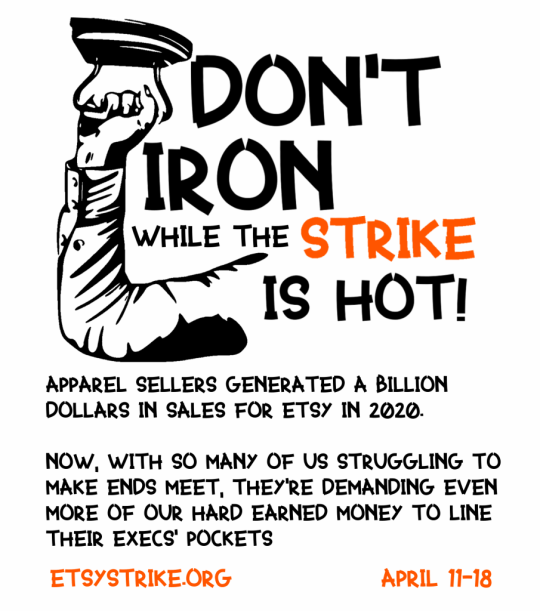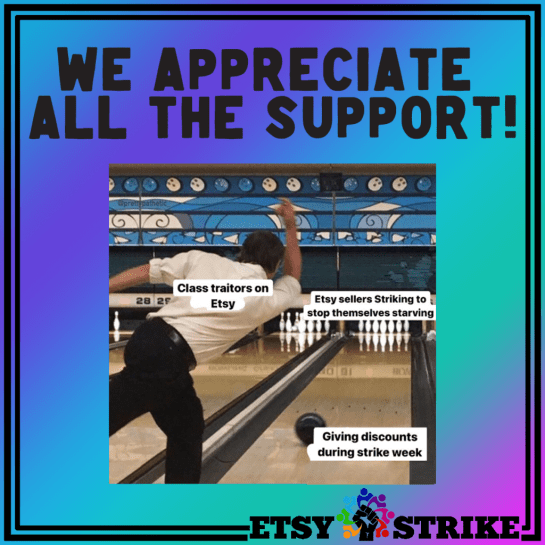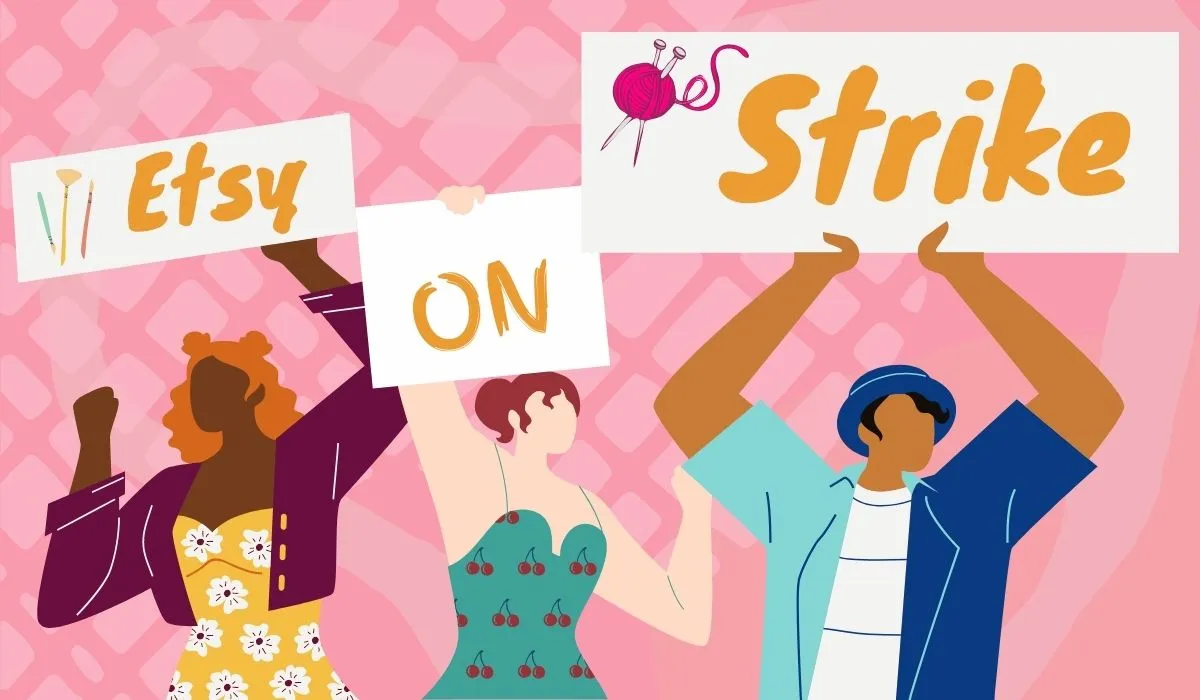April 11–18, 2022, Esty sellers are striking and asking shoppers not to cross the picket line. This strike comes after years of compounding issues, and this latest instance of “pandemic profiteering” is really the final straw. Seller Kristi Cassidy created a petition, addressed to CEO of Etsy Josh Silverman, that amassed over 48,000 signatures. The petition outlines the corporate profits racked up over the last two years and then goes into the many issues with the site. The demands include the cancellation of a seller fee increase that went into effect today, a crackdown on resellers (who aren’t hand-making their goods), an overhaul of AI support decisions, an end to the Star Seller Program, and allowing sellers to opt out of offsite ads.
You can join the effort both as a maker and a buyer! If you want to learn more and sign a petition asking Etsy to cancel the fee increase, please visit https://t.co/QYzkOiGbDs (2/2)
— Marie 🐱 @ MomoCon Prep! (@Kittygorian) April 7, 2022
Share the word and don’t cross the picket line!! #EtsyStrike pic.twitter.com/0twGGTuIhA
The push to shop small businesses and support artists have made the site look like a safe haven from the more aggressive marketing and business practices of other large online retailers, like Amazon, Wayfair, or even places like Red Bubble and Society Six. The company also amplified this public façade of care through massive media outlets as they shared how they led sellers to make masks to help COVID-19 pandemic mitigation efforts. However, millions of sellers and buyers use the site every day, and with the increased visibility and profits, so comes the exploitation of Etsy’s sellers.

From the outside looking in, or to people who passively sell on Etsy, years of growing frustration among dedicated sellers have been almost invisible. However, those working to make it an active part of their budget see each bit of this chipping away at seller profits through fees as a risk to their livelihood. Like ride sharing, food delivery, and more, Etsy has come out of that widening self-employed/side contracting work that many take as a way to supplement income. A 2015 Etsy report found that 44% of sellers used the money for necessary household expenses. That report also found that 86% of the sellers are women, and 46% of all sellers never sold their goods before selling on Etsy, making this an issue of gender and class.
Fee increases
The final straw for many sellers choosing to participate in the week-long strike was the transaction fee increasing from 5% to 6.5%. The last time this happened was in 2018, when the fee went from 3.5 to 5%. In four years, the fee has almost doubled. This is just one of many fees sellers must pay and, therefore, factor into the final price for the buyers.
Another fee imposed upon sellers is an advertising fee, which is particularly difficult to contend with because of it’s unpredictability. Etsy charges an extra 10-15% to sellers if the buyer came from an Etsy-placed advertisement on another site like Google, Facebook, etc., but it doesn’t even have to be an ad for that specific item—just an ad that links the buyer to Etsy before making a purchase. While smaller shops can opt out, all shops making over $10,000 per year have no choice.
While sellers have spoken out about this since Etsy announced it in February 2020, they’ve been largely ignored. Cassidy, for example, told Yahoo! Finance she makes custom dresses, and because a percentage of her profits may be lost to an advertising fee that may or may not be be applied based on unknown factors beyond her control, using Etsy as a platform for that kind of business is financially untenable. She and others on Reddit and other social media platforms began spreading the news about a strike in late February 2022.
Other compounding issues
With exceptions like some digital products (art, for example) and seller-made molds, everything on Etsy must be handmade. However, mass-produced items and shops are all over the site. The 2018 fee hike was supposed to address this issue, but it’s still one that many sellers report as a problem. Also, these people making non-handmade items can often make them cheaper and undercut other sellers (who are already dealing with fees).
Another issue is the AI-managed support system. The support system is understaffed and over automated, making it nearly impossible for sellers to resolve issues with Etsy. Sellers have had their shops disappear and not heard from Etsy for weeks at a time, only to get an automated message with no recourse.
And finally, there’s the matter of the Star Seller program. The Star Seller program is a badge sellers can earn (which affects search rankings) if they earn flourishing customer service by Etsy standards. Sellers see this as micromanagement and punishment for 4/5-star reviews. This is an oversimplification, but basically, this system rewards data-driven results (like responding to messages within 24 hours) that don’t necessarily paint an accurate picture and may put people at a disadvantage when it’s unwarranted.
How to participate
“Why don’t people just leave Etsy?” you ask? It’s not that easy. Etsy has become (thanks to its sellers) THE place for handmade items. According to the WallStreet Journal, Etsy had about 90 million active buyers in 2021. All these fees, like the petition put it, act as an online rental space and shop front. This gives the platform (and the CEO) more power than the sellers who make it possible. There are a few alternatives, but none with the same traffic, and if you move your business, many buyers won’t come with you.

Strikers are asking shops and sellers that can afford to close to go on “vacation mode” for as many days of the seven-day strike as possible. They also ask sellers to tell their customers what is happening. Some sellers link places to buy their work directly, like websites and Ko-fi, in these messages. Potential shoppers are asked to forgo shopping on Etsy for the week. Everyone is encouraged to share the graphics across social media and learn more about the grievances of the sellers they love to buy from.
If nothing else, Etsy, to the outside world, is losing its image as a small business-supporting platform and as an alternative to the more exploitative options of mass production. People pay extra for the one-of-a-kind nature and customization of Etsy and the personalized touches when you receive a product that reminds you that people made this. Those people deserve to share in the platform’s success.
(via The Verge, image: Alyssa Shotwell)
Want more stories like this? Become a subscriber and support the site!
—The Mary Sue has a strict comment policy that forbids, but is not limited to, personal insults toward anyone, hate speech, and trolling.—










Published: Apr 11, 2022 05:11 pm